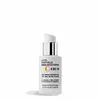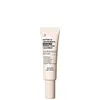What's inside
What's inside
 Key Ingredients
Key Ingredients

 Benefits
Benefits

 Concerns
Concerns

 Ingredients Side-by-side
Ingredients Side-by-side

Hyaluronic Acid
HumectantTripeptide-5
Skin ConditioningOleanolic Acid
Skin ConditioningSqualane
EmollientAscorbic Acid 15%
AntioxidantTetrahexyldecyl Ascorbate
AntioxidantTocopherol
AntioxidantNiacinamide 3%
SmoothingWater
Skin ConditioningPropylheptyl Caprylate
EmollientGlycerin
HumectantPentylene Glycol
Skin ConditioningDicaprylyl Ether
EmollientButylene Glycol
HumectantSucrose Polystearate
EmollientUndecane
EmollientCetearyl Alcohol
EmollientDisodium Cetearyl Sulfosuccinate
CleansingPhenoxyethanol
PreservativeTridecane
PerfumingHelianthus Annuus Seed Oil
EmollientCetyl Palmitate
EmollientAlcohol
AntimicrobialXanthan Gum
EmulsifyingCitric Acid
BufferingDisodium EDTA
Enantia Chlorantha Bark Extract
Skin ConditioningEthylhexylglycerin
Skin ConditioningGlyceryl Citrate/Lactate/Linoleate/Oleate
EmulsifyingPolyglyceryl-2 Oleate
EmulsifyingCaprylic/Capric Triglyceride
MaskingSodium Acetylated Hyaluronate
HumectantSodium Hyaluronate
HumectantSodium Hyaluronate Crosspolymer
HumectantAscorbyl Palmitate
AntioxidantHydrolyzed Sodium Hyaluronate
Skin ConditioningPalmitoyl Tripeptide-5
Skin ConditioningDimethylmethoxy Chromanol
AntioxidantHyaluronic Acid, Tripeptide-5, Oleanolic Acid, Squalane, Ascorbic Acid 15%, Tetrahexyldecyl Ascorbate, Tocopherol, Niacinamide 3%, Water, Propylheptyl Caprylate, Glycerin, Pentylene Glycol, Dicaprylyl Ether, Butylene Glycol, Sucrose Polystearate, Undecane, Cetearyl Alcohol, Disodium Cetearyl Sulfosuccinate, Phenoxyethanol, Tridecane, Helianthus Annuus Seed Oil, Cetyl Palmitate, Alcohol, Xanthan Gum, Citric Acid, Disodium EDTA, Enantia Chlorantha Bark Extract, Ethylhexylglycerin, Glyceryl Citrate/Lactate/Linoleate/Oleate, Polyglyceryl-2 Oleate, Caprylic/Capric Triglyceride, Sodium Acetylated Hyaluronate, Sodium Hyaluronate, Sodium Hyaluronate Crosspolymer, Ascorbyl Palmitate, Hydrolyzed Sodium Hyaluronate, Palmitoyl Tripeptide-5, Dimethylmethoxy Chromanol
Water
Skin ConditioningCaprylic/Capric Triglyceride
MaskingIsononyl Isononanoate
EmollientGlycerin
HumectantC12-15 Alkyl Benzoate
AntimicrobialPolysorbate 60
EmulsifyingPentaerythrityl Tetraisostearate
EmollientCetearyl Olivate
Mannitol
HumectantPolyacrylate Crosspolymer-6
Emulsion StabilisingPolyglyceryl-10 Oleate
Skin ConditioningEuterpe Oleracea Fruit Oil
Skin ConditioningRubus Idaeus Seed Oil
EmollientAscorbyl Palmitate
AntioxidantLactobacillus Ferment
Skin ConditioningSaccharomyces/Xylinum/Black Tea Ferment
Skin ConditioningCamellia Sinensis Leaf Extract
AntimicrobialFerulic Acid
AntimicrobialCeramide NP
Skin ConditioningCaffeine
Skin ConditioningHoney
HumectantPhospholipids
Skin ConditioningSphingolipids
EmollientHyaluronic Acid
HumectantBisabolol
MaskingAllantoin
Skin ConditioningEpigallocatechin Gallate
AntioxidantGlutathione
Ergothioneine
AntioxidantDunaliella Salina Extract
Skin ConditioningWaltheria Indica Leaf Extract
Skin ConditioningLecithin
EmollientAstaxanthin
Skin ConditioningTocopherol
AntioxidantBiotin
AntiseborrhoeicBenzimidazole Diamond Amidoethyl Urea Carbamoyl Propyl Polymethylsilsesquioxane
Cosmetic ColorantTeprenone
Skin ConditioningSorbitan Olivate
EmulsifyingLonicera Caprifolium Flower Extract
PerfumingPalmitoyl Tripeptide-5
Skin ConditioningPalmitoyl Dipeptide-5 Diaminobutyroyl Hydroxythreonine
Skin ConditioningPalmitoyl Dipeptide-5 Diaminohydroxybutyrate
Skin ConditioningPalmitoyl Tripeptide-38
Skin ConditioningDimethyl Isosorbide
SolventTetrahydrodiferuloylmethane
AntioxidantPalmitoyl Tripeptide-8
Skin ConditioningAcetyl Tetrapeptide-40
Skin ConditioningTetrahydrodemethoxydiferuloylmethane
AntioxidantTetrahydrobisdemethoxydiferuloylmethane
AntioxidantDextrin
AbsorbentHydroxypropyl Cyclodextrin
MaskingDextran
Lonicera Japonica Flower Extract
Skin ConditioningLeuconostoc/Radish Root Ferment Filtrate
AntimicrobialSodium Gluconate
Skin ConditioningHydroxyethylcellulose
Emulsion StabilisingCitric Acid
BufferingPotassium Sorbate
PreservativeSodium Hydroxide
BufferingSodium Citrate
BufferingCaprylyl Glycol
EmollientSodium Benzoate
MaskingSodium Dehydroacetate
PreservativeHydrogenated Palm Glycerides Citrate
EmollientT-Butyl Alcohol
PerfumingPolysorbate 20
EmulsifyingButylene Glycol
HumectantPhenoxyethanol
PreservativeWater, Caprylic/Capric Triglyceride, Isononyl Isononanoate, Glycerin, C12-15 Alkyl Benzoate, Polysorbate 60, Pentaerythrityl Tetraisostearate, Cetearyl Olivate, Mannitol, Polyacrylate Crosspolymer-6, Polyglyceryl-10 Oleate, Euterpe Oleracea Fruit Oil, Rubus Idaeus Seed Oil, Ascorbyl Palmitate, Lactobacillus Ferment, Saccharomyces/Xylinum/Black Tea Ferment, Camellia Sinensis Leaf Extract, Ferulic Acid, Ceramide NP, Caffeine, Honey, Phospholipids, Sphingolipids, Hyaluronic Acid, Bisabolol, Allantoin, Epigallocatechin Gallate, Glutathione, Ergothioneine, Dunaliella Salina Extract, Waltheria Indica Leaf Extract, Lecithin, Astaxanthin, Tocopherol, Biotin, Benzimidazole Diamond Amidoethyl Urea Carbamoyl Propyl Polymethylsilsesquioxane, Teprenone, Sorbitan Olivate, Lonicera Caprifolium Flower Extract, Palmitoyl Tripeptide-5, Palmitoyl Dipeptide-5 Diaminobutyroyl Hydroxythreonine, Palmitoyl Dipeptide-5 Diaminohydroxybutyrate, Palmitoyl Tripeptide-38, Dimethyl Isosorbide, Tetrahydrodiferuloylmethane, Palmitoyl Tripeptide-8, Acetyl Tetrapeptide-40, Tetrahydrodemethoxydiferuloylmethane, Tetrahydrobisdemethoxydiferuloylmethane, Dextrin, Hydroxypropyl Cyclodextrin, Dextran, Lonicera Japonica Flower Extract, Leuconostoc/Radish Root Ferment Filtrate, Sodium Gluconate, Hydroxyethylcellulose, Citric Acid, Potassium Sorbate, Sodium Hydroxide, Sodium Citrate, Caprylyl Glycol, Sodium Benzoate, Sodium Dehydroacetate, Hydrogenated Palm Glycerides Citrate, T-Butyl Alcohol, Polysorbate 20, Butylene Glycol, Phenoxyethanol
Ingredients Explained
These ingredients are found in both products.
Ingredients higher up in an ingredient list are typically present in a larger amount.
Ascorbyl Palmitate is created by combining pure Vitamin C and palmitic acid. It is an antioxidant and helps reduce hyperpigmentation.
This ingredient is a more stable version of Vitamin C, meaning it does not disintegrate as quickly when exposed to sunlight. However, studies show it does not penetrate skin as well as pure Vitamin C.
Ascorbyl Palmitate is oil soluble.
Read more about other types of Vitamin C:
Learn more about Ascorbyl PalmitateButylene Glycol (or BG) is used within cosmetic products for a few different reasons:
Overall, Butylene Glycol is a safe and well-rounded ingredient that works well with other ingredients.
Though this ingredient works well with most skin types, some people with sensitive skin may experience a reaction such as allergic rashes, closed comedones, or itchiness.
Learn more about Butylene GlycolThis ingredient is an emollient, solvent, and texture enhancer. It is considered a skin-softener by helping the skin prevent moisture loss.
It helps thicken a product's formula and makes it easier to spread by dissolving clumping compounds.
Caprylic Triglyceride is made by combining glycerin with coconut oil, forming a clear liquid.
While there is an assumption Caprylic Triglyceride can clog pores due to it being derived from coconut oil, there is no research supporting this.
Learn more about Caprylic/Capric TriglycerideCitric Acid is an alpha hydroxy acid (AHA) naturally found in citrus fruits like oranges, lemons, and limes.
Like other AHAs, citric acid can exfoliate skin by breaking down the bonds that hold dead skin cells together. This helps reveal smoother and brighter skin underneath.
However, this exfoliating effect only happens at high concentrations (20%) which can be hard to find in cosmetic products.
Due to this, citric acid is usually included in small amounts as a pH adjuster. This helps keep products slightly more acidic and compatible with skin's natural pH.
In skincare formulas, citric acid can:
While it can provide some skin benefits, research shows lactic acid and glycolic acid are generally more effective and less irritating exfoliants.
Most citric acid used in skincare today is made by fermenting sugars (usually from molasses). This synthetic version is identical to the natural citrus form but easier to stabilize and use in formulations.
Read more about some other popular AHA's here:
Learn more about Citric AcidGlycerin is already naturally found in your skin. It helps moisturize and protect your skin.
A study from 2016 found glycerin to be more effective as a humectant than AHAs and hyaluronic acid.
As a humectant, it helps the skin stay hydrated by pulling moisture to your skin. The low molecular weight of glycerin allows it to pull moisture into the deeper layers of your skin.
Hydrated skin improves your skin barrier; Your skin barrier helps protect against irritants and bacteria.
Glycerin has also been found to have antimicrobial and antiviral properties. Due to these properties, glycerin is often used in wound and burn treatments.
In cosmetics, glycerin is usually derived from plants such as soybean or palm. However, it can also be sourced from animals, such as tallow or animal fat.
This ingredient is organic, colorless, odorless, and non-toxic.
Glycerin is the name for this ingredient in American English. British English uses Glycerol/Glycerine.
Learn more about GlycerinHyaluronic acid is naturally found in healthy skin. It is a humectant, meaning it draws moisture to your skin.
This ingredient helps hydrate, soothe, and protect the skin.
What makes hyaluronic acid so hydrating? It has the capacity to bind or hold large amounts of water.
Fun fact: It is already naturally found in our bodies, such as the fluids of our eyes and our joints.
Studies find this ingredient to have anti-inflammatory and anti-microbial properties. This can help speed up wound-healing.
Hyaluronic acid can be irritating if the molecule has a low-molecular weight, or if the molecules are small.
One study found low-molecular weight hyaluronic acid to be pro-inflammatory, meaning some people may experience irritation. This is because our bodies use hyaluronic acid in the wound-healing process to signal to our bodies, via irritation, that something needs healing.
The same study found high-molecular weight hyaluronic acid to be anti-inflammatory.
These are some other common types of Hyaluronic Acid:
Learn more about Hyaluronic AcidThis synthetic peptide is created from lysine, valine, and palmitic acid.
According to the manufacturer, in-vitro studies show tissue growth and collagen synthesis. Another in-vivo study found 60 volunteers saw a significant reduction in wrinkles after 84 days.
Due to its palmitic acid base, this peptide may not be fungal-acne safe.
Learn more about Palmitoyl Tripeptide-5Phenoxyethanol is a preservative that has germicide, antimicrobial, and aromatic properties. Studies show that phenoxyethanol can prevent microbial growth. By itself, it has a scent that is similar to that of a rose.
It's often used in formulations along with Caprylyl Glycol to preserve the shelf life of products.
Tocopherol (also known as Vitamin E) is a common antioxidant used to help protect the skin from free-radicals and strengthen the skin barrier. It's also fat soluble - this means our skin is great at absorbing it.
Vitamin E also helps keep your natural skin lipids healthy. Your lipid skin barrier naturally consists of lipids, ceramides, and fatty acids. Vitamin E offers extra protection for your skin’s lipid barrier, keeping your skin healthy and nourished.
Another benefit is a bit of UV protection. Vitamin E helps reduce the damage caused by UVB rays. (It should not replace your sunscreen). Combining it with Vitamin C can decrease sunburned cells and hyperpigmentation after UV exposure.
You might have noticed Vitamin E + C often paired together. This is because it is great at stabilizing Vitamin C. Using the two together helps increase the effectiveness of both ingredients.
There are often claims that Vitamin E can reduce/prevent scarring, but these claims haven't been confirmed by scientific research.
Learn more about TocopherolWater. It's the most common cosmetic ingredient of all. You'll usually see it at the top of ingredient lists, meaning that it makes up the largest part of the product.
So why is it so popular? Water most often acts as a solvent - this means that it helps dissolve other ingredients into the formulation.
You'll also recognize water as that liquid we all need to stay alive. If you see this, drink a glass of water. Stay hydrated!
Learn more about Water